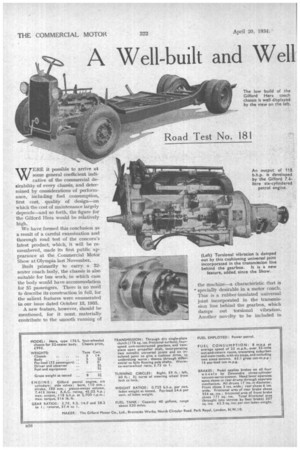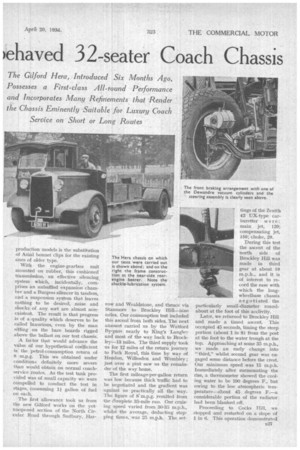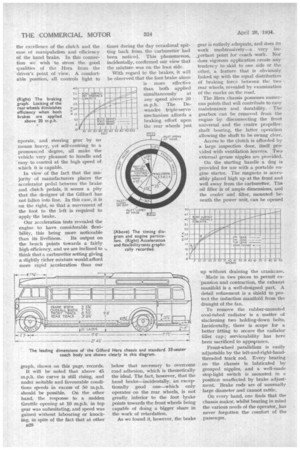A Well-built and Well
Page 40

Page 41

Page 42

If you've noticed an error in this article please click here to report it so we can fix it.
whaved 32-seater Coach Chassis
The Gilford Hera, Introduced Six Months Ago, Possesses a First-class All-round Performance and Incorporates Many Refinements that Render the Chassis Eminently -Suitable for Luxury Coach
Service on Short or Long Routes
WERE it possible to arrive ak some general coefficient indicative of the commercial desirability of every chassis, and determined by considerations of performance, including fuel consumption, first cost, quality of design—on which the cost of maintenance largely depends—and so forth, the figure for the Gilford Hera would be relatively
high. .
We have formed this conclusion as a result of a careful examination and thorough road test of the concern's latest product, which, it will be remembered, made its first public appearance at the Commercial Motor Show at Olympia last November.
Built primarily to carry a 32seater coach body, the chassis is also suitable for bus work, in which case the body would have accommodation (Or 35 passengers. There is no need to describe its construction in full, for the salient features were enumerated in our issue dated October 13, 1933.
A new feature, however, should be mentioned, for it must, materially contribute to the smooth running of
the machine—a characteristic that is
• specially desirable in a motor coach. This is a rubber-insulated universal joint incorporated in the transmission line behind the gearbox, which damps out torsional vibration. Another novelty to be included in production models is the substitution of Arnal bonnet clips for the existing ones of older type.
With the engine-gearbox unit mounted on rubber, this. cushioned transmission, an effective silencing. system which, incidentally, comprises an unbaffied expansion chamber and a Burgess silencer in tandem, and a suspension system that leaves nothing to be desired, noise and shocks of any sort are almost nonexistent. The result is that progress is of a quality which deserves to be called luxurious, even by the man sitting on the bare boards rigged above the ballast on our test chassis.
A factor that would advance the value of our 'hypothetical coefficient is the petrol-consumption return of 8 m.p.g. This we obtained under conditions definitely more severe than would obtain on normal coachservice routes. As the test tank provided was of small capacity we were compelled to conduct the test in stages, consuming 13 gallon of fuel on each.
The first allowance took us from the new Gifford works on the yetunopened section of the North Circular Road through Sudbury, Har
row and Wealdstone, and thence via Stanmore to Brockley Hill—nine miles. Our consumption test included this ascent from both sides. The next amount carried us by the Watford By-pass nearly to King's Langley and most of the way back to Brockley-13 miles. The third supply took us for 12 miles of the return journey to Park Royal, this time by way of Hendon, Willesden and Wembley; just over a pint saw us the remainder of the way home.
The first mileage-per-gallon return was low because thick traffic had to be negotiated and the gradient was against us practically all the way. The figure of 8‘ m.p.g. resulted from the complete 35-mile run. Our cruising speed varied from 30-35 m.p.h., whilst the average, deducting stopping times, was 25 m.p.h. The set
tings of the Zenith 42 UX-type carburetter were: main jet, 120; compensating jet, 150; choke, 29.
During this test the ascent of the north side of Brockley Hill was made in third gear at about 19 m.p.h., and it is of interest to record the ease with which the longwheelbase chassis negotiated the particularly small-diameter roundabout at the foot of this acclivity.
Latex, we returned to Brockley Hill and made a timed ascent This occupied 45 seconds, timing the steep portion (about 1 in 8) from the post at the foot to the water trough at the top. Approaching at some 35 m.p.h., we made an early change into "third," whilst second gear was engaged some distance before the crest. Our minimum speed was 15 m.p.h. Immediately after surmounting the rise, a thermometer showed the cooling water to be 190 degrees F., but owing to the low atmospheric temperature—about 45 degrees F.—a considerable portion of the radiator had been blanked off.
Proceeding to Cocks Hill, we stopped and restarted on a slope of 1 in 6. This operation demonstrated i127 the excellence of the clutch and the ease of manipulation and efficiency of the hand brake. In this connection we wish to stress the good qualities of the Hera from the driver's point of view. A comfortable position, all controls light to operate, and steering gear by no means heavy, yet self-centring to a pronounced degree, all make the vehicle very pleasant to handle and easy to control at the high speed of which it is capable.
In view of the fact that the majority of manufacturers places the accelerator pedal between the brake and clutch pedals, it seems a pity that the designer of the Gilford has not fallen into line. In this case, it is on the right, so that a movement of the foot to the left is required to apply the brake.
Our acceleration tests revealed the engine to have considerable flexibility, this being more noticeable than its liveliness. Its output on the bench points towards a fairly high efficiency, and we are inclined to think that a carburetter setting giving a slightly richer mixture would afford more rapid acceleration than our
graph, shown on this page, records.
It will be noted that above 45 m.p.h. the curve is still rising, and under suitable and favourable conditions speeds in excess of 50 m.p.h. should be possible. On the other hand, the response to a sudden throttle opening at 10 m.p.h. in top gear was unhesitating, and speed was gained without labouring or knocking, in spite of the fact that at other B28 times during the day occasional spitting back from the carburetter had been noticed. This phenomenon, incidentally, confirmed our view that the mixture was on the lean side.
With regard to the brakes, it will be observed that the foot brake alone is more effective than both applied simultaneously at any speed above 20 m.p.h. The Dewandre triple-servo mechanism affords a braking effort upon the rear wheels just below that necessary to overcome road adhesion, which is theoretically the ideal. The fact, however, that the hand brake—incidentally, an exceptionally good one—which only operates on the rear wheels, is not greatly, inferior to the foot brake points towards the front wheels being capable of doing a bigger share in the work of retardation.
As we found it, however, the brake gear is entirely adequate, and does its work unobtrusively—a very lin„portant point for coach work. Nor does vigorous application create any tendency to skid to one side or the other, a feature that is obviously linked up with the equal distribution of braking force between the two rear wheels, revealed by examination of the marks on the road.
The Hera chassis possesses numerous points that will contribute to easy maintenance and durability. The gearbox can be removed from the engine by disconnecting the front universal and the centre propellershaft bearing, the latter operation allowing the shaft to be swung clear.
Access to the clutch is afforded by a large inspection door, itself provided with ventilation louvres. Two external grease nipples are provided.
On the starting handle a dog is provided for use with a portable engine starter. The magneto is accessibly placed high up at the front and well away from the carburetter. The oil filler is of ample dimensions, and the cooler and filter, mounted beneath the power unit, can be opened up without draining the crankcase.
Made in two pieces to permit expansion and contraction, the exhaust manifold is a well-designed part. A detail refinement is a shield to protect the induction manifold from the draught of the fan.
To remove the rubber-mounted oval-tubed radiator is a matter of slackening two holding-down bolts. Incidentally, there is scope for a better fitting to secure the radiator filler cap ; serviceability has here been sacrificed to appevance.
Front-wheel parallelism is easily adjustable by the left-and-right-handthreaded track rod. Every bearing on the chassis is lubricated by grouped nipples, and a well-made stoplight switch is mounted in a position unaffected by brake adjustment. Brake rods are of unusually large diameter and cannot rattle.
On every hand, one finds that the chassis maker, whilst bearing in mind the various needs of the operator, has never forgotten the comfort of the passenger.




























































































